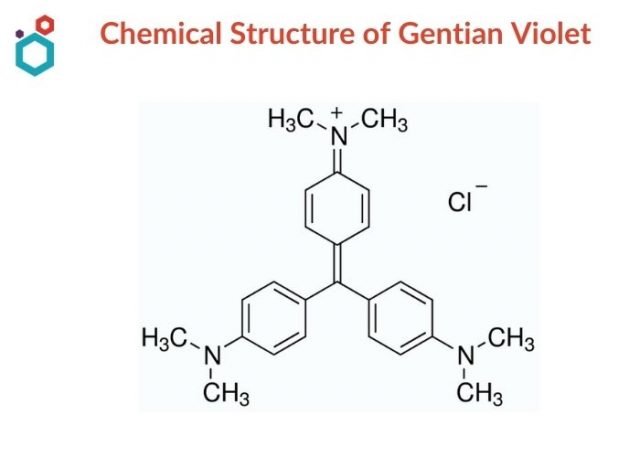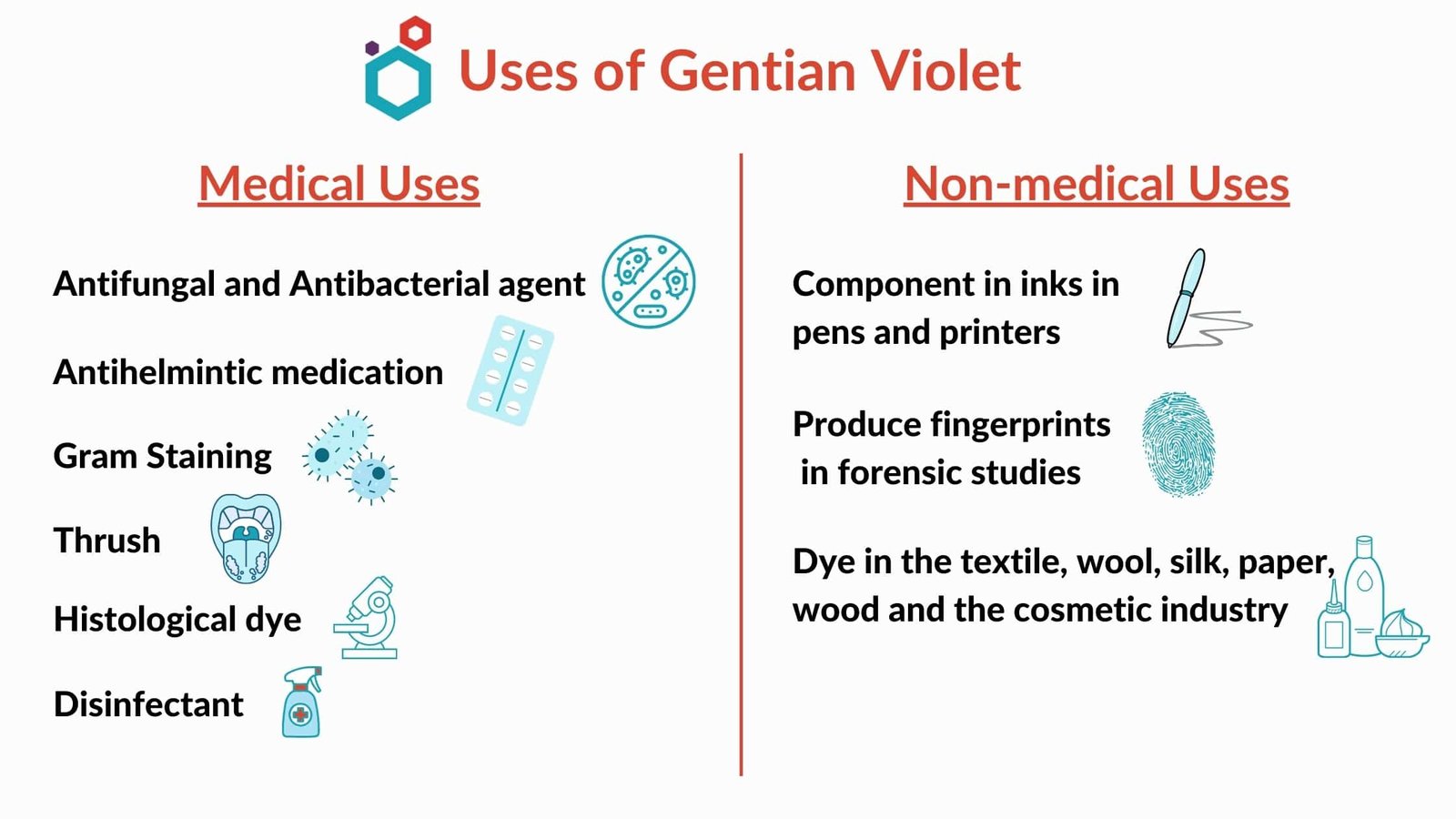Home » Blog » Gentian Violet » Gentian violet | Properties, Uses and Side Effects
What is Gentian Violet (Crystal Violet)?
Gentian Violet is a primary dye that is used for the purpose of Gram Staining. It is a triarylmethane dye which is also known as Crystal violet. The name gentian violet was first used to denote a combination of methyl pararosaniline stains (methyl violet), although it is now frequently used interchangeably with Crystal Violet. It is not produced from gentians or violets, and its name alludes to its colour, which resembles the petals of some gentian flowers.
Note for the reader – In a few instances, this article refers to Gentian Violet as GV.
Gentian Violet is an alkaline dye made up of organic chloride salts that belong to the triphenylmethane family. It has a wide range of biological and commercial uses, including fingerprinting, dyeing ink, antifungal, antibacterial, anthelmintic agents, and histological staining. Basic Violet 3, Crystal Violet, Hexamethyipararosaline chloride, and Methyl Violet 10B are some of the other names for Gentian Violet.

When it’s in powder form, it’s a dark green chemical with a metallic shine, but when it’s dissolved in a solvent, it becomes purple. The dye’s various shades are due to the different charged states.
Structure and Properties

- Gentian Violet is an aniline-derived dye with the chemical formula of C25N3H30Cl and a molecular weight of 408.0 g/mol.
- Gentian Violet is also called Crystal Violet, Aniline violet, Basic violet 3, Baszol Violet 57L, Brilliant Violet 58, Hexamethyl-p-rosaniline chloride, Methylrosanilide chloride, Methyl Violet 10B, Methyl Violet 10BNS, Pyoktanin.
- It occurs as greenish to dark-green powder with a metallic lustre.
- The melting point of Gentian Violet is 205 °C (401 °F; 478 K).
- It is sensitive to light.
- It is soluble in water, alcohol and chloroform but is insoluble in ether and xylene.
- Gentian Violet has a (purple) blue-violet tint in an aqueous or alcohol solution, with the colour primarily depending on the acidity of the solution.
- It is exothermic in nature when reacting with reducing agents releasing hydrogen gas.
- When reacting with oxidizing agents, it reacts vigorously.
- When heated to decomposition above 215 °C, it emits very toxic fumes of Nitrogen oxides and Chloride.
- It shows a UV max of 590 nm in water.
Synthesis
N, N-dimethylaniline is used to make Gentian Violet. This product is concentrated, chlorinated, and added to other processes. In the presence of phosphorus oxychloride, it may also be produced by reacting N, N-dimethylaniline with Michler ketone. It is then treated with hydrochloric acid in an azeotropic process. Following that, the chemical is recrystallized in hot water to produce the compound.
Mechanism of action
Gentian Violet is an aniline dye that has antifungal and antimitotic effects. Gentian violet (GV) breaks down into positive (GV+) and negative (Cl-) ions, which may permeate both gram +ve and gram -ve bacteria. The negatively charged elements of the bacterial cell wall, including lipopolysaccharide, peptidoglycan, and DNA, engage with the GV+ ions. Fungal cells are considered to go through a similar cell penetration and DNA binding process. Because Gentian violet is a mutagen and a mitotic toxin, it inhibits cell proliferation. Additionally, by increasing susceptibility on prokaryotic or eukaryotic membranes, this chemical dissipates the action potential, resulting in respiratory suppression and the death of cells.
Uses

Medical Uses
- Gentian Violet can be used to kill or delay the development of bacteria as an antibacterial and antifungal agent. It may also be used to kill fungi by preventing them from reproducing or growing.
- GV can be used for disinfection to stop germs from reproducing or to kill them. It is available as an antiseptic liquid under the brand name Walgreens.
- GV is an antihelminthic medication that may also be used to destroy parasitic worms.
- Gentian Violet is used for Gram staining. It is done in three steps. First, staining with GV which is a water-soluble dye followed by its decolourization and counterstaining with safranin. Gram-positive bacteria (which have a thicker peptidoglycan layer) retain GV stain during the decolourization process, but Gram-negative bacteria (with a thinner peptidoglycan layer) lose GV stain and are instead stained by safranin.
- GV is also employed in the microscopic analysis of cells as a histology dye to highlight and contrast certain elements of the cell, such as nuclei and cytoplasm.
- Because of its stability and low cost, less developed nations use gentian violet to cure thrush in HIV patients.
- In tissue samples, GV is useful for analysing or identifying bacterial contamination. It’s also imperative to evaluate the cytotoxic/cytostatic impacts of archaea on tumour cell lines and evaluate various species of archaea.
- It’s also occasionally used as an inexpensive technique to label research mice with identifiable markings; because many lab mouse strains are albino, the purple colour lingers on their hair for several weeks.
- GV is used to see how chemotherapeutics and other compounds affect cell growth and survival. Because adherent cells detach from culture plates after cell death, this may be used to show changes in growth and quantify cell death in response to medications that cause cell death.
- GV can also be used for screening cell adhesion because of its ability to bind to cell DNA and proteins in cells. In this procedure, the dye works as an intercalating agent, allowing for accurate DNA quantification that is proportional to the number of cells in the culture. It takes around 6 minutes to finish the staining process. GV aids cell visibility by giving the nucleus of cells a vivid purple hue.
Non-Medical uses
- It is used as a dye in the textile, wool, silk, paper, wood and the cosmetic industry.
- It is also used as a component in black and navy blue inks in pens and printers.
- It’s also used to colour various products such as fertilisers, types of antifreeze, detergents, and leather.
- GV is used to produce fingerprints in forensic studies.
Side effects
- Redness, swelling, or irritation at the application site may occur.
- If Gentian violet comes in contact with granulation tissue, it can cause permanent skin colouring. Due to this reason, it should not be used on ulcerative lesions of the face.
- In a few intertriginous zones, it can also cause allergies, dermatitis or necrosis.
- Because of reports of animal carcinogenicity, its usage for bacterial and pathogenic fungus therapy in animals, such as Staphylococcus and Candida species, has reduced.
- When it is used at a higher concentration then it can cause discomfort in the mucous membranes (e.g., the tissue lining, gastrointestinal tract, and vaginal tract).
- It might cause side effects like nausea, vomiting, diarrhoea, and stomach discomfort if taken orally.
Precautions
- Gentian violet will stain the skin and clothing. Avoid getting the medicine on your clothes.
- Consult your doctor or pharmacist before taking this product if you have any metabolic disorder (porphyria).
- If a person somehow comes in contact with Gentian Violet then he should be kept away from heat, sparks and flames. He should be moved to an open area with fresh air and a physician should be consulted immediately.
- If it comes in contact with the eyes then it can cause serious damage. The person using the stain should wear a proper PPE kit as a precautionary measure.
- Contact with skin, eyes and mouth should be avoided while handling the chemical.
FAQs
Q. Why is Gentian Violet banned?
Gentian violet has been outlawed in some nations because of concerns over its possibly carcinogenic and poisonous effects. In some countries, such as the United States, it is only prohibited for specific applications, such as in dog food; however, in other countries, such as Australia and Canada, it is prohibited for use completely.
Q. Is Gentian Violet banned in the US?
The use of gentian violet in animal feed or as a veterinary drug in food for animals is prohibited in the US.
Q. How to use Gentian Violet for thrush?
Thrush is a fungal (yeast) infection caused by Candida (fungus) that can grow in your mouth, throat and other parts of your body. Gentian violet 1% solution is used topically for treating thrush by applying it directly to the affected areas.
Q. Is Gentian Violet safe for babies?
Gentian violet has been discovered as a possible carcinogen, mutagen, and toxin. In addition, negative effects in babies have been reported, including irritation of the skin and mouth, mouth ulcers, esophageal and throat inflammation, and facial oedema.
Q. What is Gentian Violet made of ?
Gentian Violet is an alkaline dye that comes from the family of compounds known as triphenylmethane. It is the organic chloride salt of N, N-dimethylaniline.
Q. How to remove Gentian Violet from your skin?
To effortlessly remove gentian violet off your skin, use baby wipes and olive oil to remove the purple streaks immediately after application. However, you can remove dried stains by washing the affected area with alcohol, hydrogen peroxide, or a vinegar and detergent solution.
Q. Can you buy gentian violet over the counter?
Gentian Violet is available without a prescription from healthcare practitioner and can be bought over the counter.
Q. What kind of stain is Gentian Violet?
Gentian Violet is a primary stain and is positively charged. This stain is used in Gram’s technique of differentiating Gram-positive and Gram-negative bacteria.
Q. Can you use gentian violet in your mouth?
Gentian Violet is a staining dye and can be toxic if swallowed. It can stain the mouth. It might also cause irritation in the digestive tract.
Q. Can gentian violet be used on open wounds?
Gentian Violet is a feasible alternative to be used as a topical agent in the treatment of minor and superficial wounds.
Q. Where to buy Gentian Violet?
Macsen Labs is the leading manufacturer and supplier of Gentian Violet with GMP and ISO certification.
Resources
Biological Stains | Classification, Examples & Uses
Disclaimer-
The information provided here is based on general knowledge, articles, research publications etc and we do not claim the authenticity of any of the information provided above. We do not claim or suggest/advise any medical, therapeutic, health or nutritional benefits of Gentian Violet. We do not supply or promote our Gentian Violet product for the applications which are covered by valid patents and which are not approved by the FDA.
Macsen Labs is a manufacturer and supplier of several grades of Gentian Violet such as:-
Methylrosanilinium Chloride EP (Ph Eur) / BP
Crystal Violet (Basic Violet 3, Methyl Violet 10B, C.I 42555)


